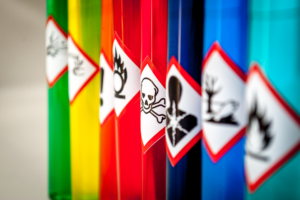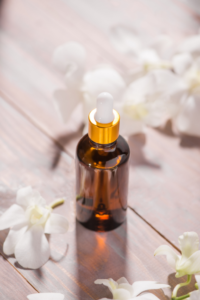
Phthalates: What They Are, Where They Are Found, and Why We Should Care
There has been increasingly more and more conversation about products that contain phthalates and how they could be detrimental to our health. However, it is often difficult to understand what phthalates are, which products they are in, and their exact adverse effects on our health.
What are Phthalates?
Simply put, phthalates are man-made chemicals used to make plastics more durable, flexible, transparent, and long-lasting. They are also used to dissolve other materials. Phthalates are colorless and odorless liquids that do not evaporate easily. In fragrances specifically, phthalates are often used to dissolve raw materials because they offer good solubility, low odor impact, higher flashpoint, and cost-effectiveness.
Where are Phthalates found?
Phthalates are in hundreds, if not thousands, of products, including vinyl flooring, lubricants, fragrances, food packaging, personal-care products, and home cleaning products.
According to Safer Chemicals Healthy Families, an organization focused on eliminating hazardous chemicals from our lives, “Food is the leading source of exposure. Phthalates have been found in dairy products, meats, fish, oils & fats, baked goods, infant formula, processed foods, and fast foods. Phthalates are not intentionally added ingredients but rather “indirect” food additives. They easily escape from food processing equipment, food packaging, and food preparation materials, and contaminate food at points all along the supply chain.”
Why Should We Care about the Presence of Phthalates?
An increase in studies regarding phthalates, their toxicity, pervasive human and environmental exposure, and adverse health effects they could impose has caught the attention of several federal agencies. Concerns regarding phthalates and their link to several health issues (asthma, ADHD, breast cancer, fertility issues, Type II diabetes, neurodevelopmental issues, behavioral issues, and damage to the liver, kidneys, and lungs) has led to the ban of these toxins in toys and children’s products in the Consumer Product Safety Improvement Act of 2008.

In addition, the CDC has recommended that phthalates and their adverse health effects be studied further following recent concerns surrounding these chemicals. For example, reports from the US Center for Disease Control state widespread exposure of phthalates across the general American public. Due to widespread concern, the CDC has added phthalates to their national biomonitoring program, which has unlocked funding for many studies regarding these toxic chemicals. In addition, these toxic chemicals have caught the attention of the United States Environmental Protection Agency, which has developed an action plan for assessing and managing these types of chemicals.
The Phthalate-Free Movement
In recent years, the term “phthalate-free” appears on many products, especially in personal and home care industries. However, achieving completely phthalate-free products is tricky because, as previously stated, while products may not directly contain phthalates, the toxins may escape from processing equipment during manufacturing.
Due to increased consumer awareness concerning phthalates, many companies and manufacturers across various industries have switched to non-phthalates, which are phthalate-free plasticizers. Some examples of these phthalate-free replacements for the toxic chemicals include diisononylcyclohexane-1,2-dicarboxylate (DiNCH), bis(2-ethylhexyl) terephthalate (DEHT), bis(2-ethylhexyl) adipate (DEHA), and some other soy-based plasticizers.
To avoid exposure to phthalates as much as possible, it is essential to make sure that you do not heat food in plastics, avoid plastic food packaging when you can, try to store food in glass or stainless steel, and have reusable water bottles. While this is the first step towards a phthalate-free world, it is essential to note that phthalates are almost everywhere. Therefore, when shopping for personal and home care products, it is crucial to choose those labeled as 100% phthalate-free, as toxins are often within the fragrances and packaging of these items.
Phthalates used in cosmetic applications are dibutyl phthalate (DBP), dimethyl phthalate (DMP), and diethyl phthalate (DEP). An issue regarding phthalates specifically arises when looking at products that contain fragrances, as manufacturers are permitted to include thousands of ingredients under the stand-alone words “fragrance,” “perfume,” or “flavor.” Specifically, DEP is still commonly used in fragrances as solvents to dissolve raw materials. In candles specifically, companies often use phthalates in fragrances to increase the hot throw of scent when used in soy wax.

Thankfully, many brands are becoming conscious of the health risks caused by phthalates and the consumer’s desire to avoid the toxic chemicals as much as possible. Therefore, many products are now labeled explicitly as phthalate-free. However, it is essential to read the fine print when shopping. Many companies that sell fragrant products claim to be phthalate-free but will state in small print that the product is free of dibutyl phthalates, which is misleading as DBP is not typically in fragrance.
The following phthalates:
- BBP (butyl benzyl phthalate): may affect child development during pregnancy.
- DBP (di-n-butyl phthalate): may affect child development during pregnancy and harm the male and female reproductive systems.
- DEHP (di(2-ethylhexyl)phthalate): may increase the risk of cancer and harm the male reproductive system. Exposure during pregnancy may affect child development.
- DIDP (di-isodecyl phthalate): may affect child development during pregnancy.
- DINP (diisononyl phthalate): may increase the risk of cancer.
- DnHP (di-n-hexyl phthalate): may harm the male and female reproductive systems.
may be present in products when the product (if accessible to Californians in stores, through the mail, or online purchases) has California’s Prop 65 warning on its labeling, as exposure to these specific phthalates must be made known to Californians through the warning label. Therefore, if a product contains these specific phthalates and is available to Californians for purchase, you will see the warning label on the item.
As a side note, shopping products that do not require California’s warning label could be beneficial. It ensures that other toxic chemicals and carcinogens found on the list are also not included in the product, or else the warning label would be required (if the product is available for purchase by Californians).
Zero Breast Cancer, an organization that promotes breast cancer risk reduction by analyzing scientific research, has created a phthalate fact sheet to help you understand the negative effects of these toxic chemicals and teach you how to read product labels to avoid phthalate compounds.
While many companies across different product categories (including hair care, cleaning products, and fragrances) aim to be phthalate-free, you can shop Halarosis if you are specifically looking for candles containing phthalate-free fragrances. We have ensured that all fragrances used in our manufacturing are 100% phthalate-free by working with our supplier.






0 Comments